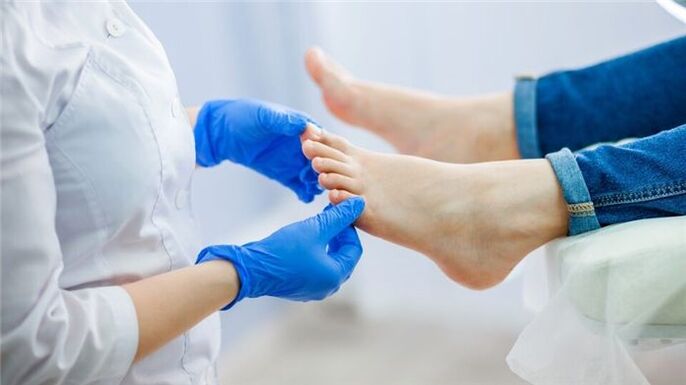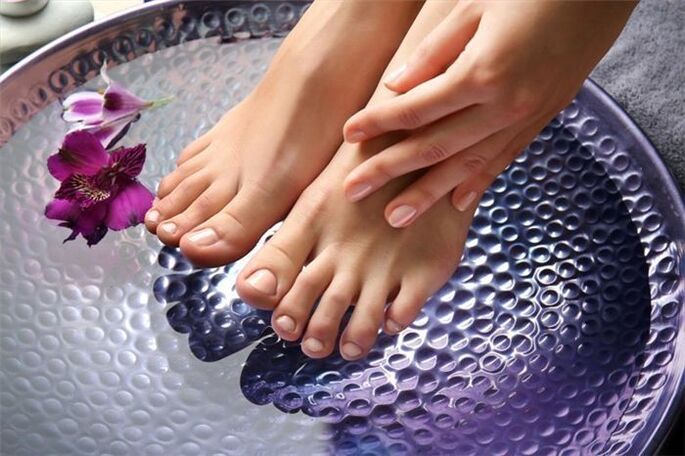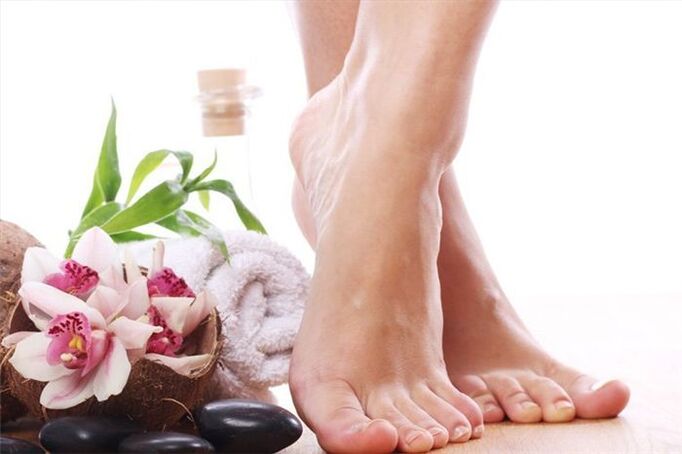Classification of antifungal tablets
Antimycotic pills vary depending on their structure and mechanism of action.
polyenesthey quickly kill fungal spores by disrupting membrane integrity. They are well tolerated by the body and do not have a negative effect on the liver and digestive system.
For the treatment of fungal infection in the initial stages, external drugs are used - solution, varnish or cream, hydrogen peroxide.
The treatment of fungi with tablets is recommended when ointments, creams, oils, sprays and other topical agents have not yielded results.
Effective tablets against nail fungus
The pharmacological market offers a wide range of antifungal drugs in the form of tablets, which differ in the main active ingredient, manufacturer and cost.
Active ingredient:
- Terbinafine Hydrochloride
- Fluconazole
- Terbinafine
- Ketoconazole
- Itraconazole
- Griseofulvin
- Itraconazole
- Ketoconazole
- Terbinafine
- Natamycin
The type of fungal infection and the severity of the disease should be taken into account when choosing a drug. Before starting therapy, it is necessary to determine the nature of onychomycosis, since many drugs affect only a certain group of pathogens.
A drug based on terbinafine hydrochloride
This is a tableted antifungal drug that has a pathogenic effect on the pathogenic microorganisms that cause onychomycosis. It contains an active ingredient of the same name. The product promotes the destruction of the outer membrane of fungal pathogens, which leads to their death.
Cheap tablets are used to treat onychomycosis, dermophytosis and ringworm.
- renal failure;
- children under 3 years of age;
- period of pregnancy and breastfeeding;
- hypersensitivity to terbinafine.
The drug can cause side effects - headache, nausea, loss of appetite, stool disorder, painful abdominal cramps.
With long-term use, you should systematically monitor liver function and stop drinking alcoholic beverages.
The recommended dose is 1 tablet per day. The duration of treatment is determined individually. In advanced stages of onychomycosis, use is allowed for 8-12 weeks.
It is a drug belonging to the group of triazole antifungal agents
It is an effective antifungal drug produced in various pharmacological forms. The drug is used to get rid of fungal infections, as well as for preventive purposes. Its use is allowed in case of liver diseases, but under the supervision of a doctor.
- kidney diseases;
- the period of exacerbation of psoriasis and other dermatological diseases of an inflammatory nature;
- pregnancy;
- individual intolerance to the active components of fluconazole.
To treat nail fungus, the medicine must be taken once a day for 4 weeks. After that, the dose is reduced to 1 tablet every 7 days. The product has a cumulative effect - after 4-5 days of use, a high concentration of the substance accumulates in the stratum corneum of the nail plate.
To prevent remission, the drug should be taken until the healthy nail plate has fully grown.
In rare cases, the drug causes side effects such as nausea, stomach pain, itching and burning in the areas affected by the fungus, as well as various allergic reactions.
Medicine based on terbinafine hydrochloride 10 mg
It is an antifungal drug that is highly effective against many fungal microorganisms. The active ingredient terbinafine inhibits the biosynthesis of sterols in fungal cells, which leads to the rapid destruction of infectious agents.
The drug is well tolerated by the body and has a minimal number of contraindications for use - severe forms of kidney disease, increased sensitivity to the active ingredients in the preparation. Approved for the treatment of liver diseases.
For adults, 1 tablet per day is recommended for 3-6 weeks. To cure the advanced stages of nail fungus, the duration of the therapeutic course is increased to 10-12 weeks.
In extremely rare cases, it causes headaches, nausea, a feeling of fullness in the stomach, allergic manifestations, and skin rashes.
A drug based on ketoconazole
Ketoconazole is one of the most powerful antifungal agents. It is used to treat severe, advanced stage systemic fungal infections.
Its use is recommended in case of complete damage to the nail plates, which also affects the nearby soft parts. In addition, the drug is prescribed when antifungal agents for local use have not given positive results.
Approved for the treatment of liver diseases, but best under the supervision of a doctor and regular liver tests.
The drug cannot be used to treat nail fungus in children under 12 years of age, pregnant and lactating women, and in case of individual intolerance.
Side effects: nausea and vomiting, bloating and abdominal pain, conjunctivitis, allergic skin rashes, apathy, nervousness, in men - temporary deterioration of libido.
The recommended dose for nail fungus is 1-2 tablets per day, depending on the severity of the fungal infection. The duration of therapy is 4-5 weeks.
Itraconalose-based preparation 0. 1 g
Itraconazole is used in cheap medicines to treat nail fungus. It inhibits ergosterol in the cell membrane of pathogenic microorganisms and has a harmful effect on almost all known pathogens of nail fungus. Tablets containing intraconazole are used to treat fungal infections, regardless of the location and extent of the lesions.
The medicine should not be used in case of exacerbation of kidney diseases, as well as in case of hypersensitivity to the active ingredients in the preparation. In case of liver diseases, it is used during the period of remission.
A cheap and effective drug can cause negative reactions - development of dysbiosis, bloating, stomach pain, headache and dizziness. In rare cases, the drug may cause swelling of the soft tissues.
For the treatment of nail onychomycosis, it is recommended to take 1 tablet in the morning and in the evening for 10-12 weeks. After that, the medicine must be taken in weekly courses with a break of 2-3 weeks.
Itraconazole-based drug
The antimycotic effect of the drug is provided by the active ingredient itraconazole. In the case of fungal infection of the fingernails and toenails, the medicine should be taken with 2 tablets once a day, or the dose should be divided into two doses. The duration of the treatment is 8-12 weeks.
It can also be used at home for weekly therapy. After taking the tablets for 7 days, a 3-week break must be taken, and then the treatment must be continued. In case of fungal infections of the nail plates, at least 3 courses are required. The tablets are taken in 2 pieces, in the morning and in the evening.
The drug is well tolerated by the body. In rare cases, side effects may develop - nausea, constipation, allergic skin rashes, headache, loss of appetite, nervousness, fatigue, weakness. It should be used with caution in case of exacerbation of liver diseases.
Itraconazole-based drug 100 mg
The antimycotic drug contains 100 mg of the active ingredient itraconazole, which has a destructive effect on the membrane of fungi and leads to the death of pathogenic microorganisms. This is a broad-spectrum drug, so it is prescribed for advanced stages of onychomycosis.
The drug should not be taken in case of heart failure or low sucrose level in the blood. The drug should be taken with extreme caution if you suffer from fructose intolerance.
In case of fungal nail infections, it is recommended to take 1 tablet in the morning and in the evening, 20-30 minutes after a meal. The average duration of treatment is 2-3 weeks. The reception stops only when the healthy nail plates grow back.
Taking the drug can be accompanied by side effects - nausea, vomiting, stool disorder, loss of appetite, headache, dizziness, peripheral neuropathy, skin rash. In some cases, women may experience menstrual irregularities. It should be used with caution in case of exacerbation of liver diseases.
Ketoconazole-based drug 200 mg
It is a broad-spectrum drug with antimycotic and antibacterial effects. The main active ingredient of the product is ketoconazole, which is extremely effective against dermatophytes, eumycetes, dimorphic and yeast pathogens.
For the treatment of fungal nail diseases, it is recommended to take 1-2 tablets during the day. The exact dose of the drug is determined by the doctor depending on the severity of the disease. The average duration of the therapy course is 12-15 weeks.
The medicine cannot be taken during pregnancy, breastfeeding, or for the treatment of children under 3 years of age.
It should be used with caution in case of exacerbation of liver diseases. The tablets can cause negative reactions from the internal organs - stool disorder, nausea, vomiting, skin rashes, drowsiness, loss of strength.
In some cases, the use of the drug in men is associated with a decrease in sexual activity and a deterioration of erectile function, which negatively affects intimate life.
Short summary
Effective and inexpensive antifungal agents produced in the form of tablets are used against fungal infections of nail plates of various origins. They are prescribed when ointments, gels and other means of external application have not brought the desired result.
Broad-spectrum tablets are effective against most pathogenic microorganisms and fungal pathogens. The treatment of mycosis is long and complex, the drug must be taken until the healthy nail plates grow back.
Effective antifungal agents
Do your nails turn yellow and peel, do you have dandruff, or are you overcome by thrush? All of these are symptoms of a fungal infection, which means that treatment is essential. Let's talk to experts about what effective antifungal agents exist and how to choose them correctly

Mycoses or fungal infections are a very common disease. Fungi usually affect the skin, mucous membranes and nails, but they can also affect internal organs. Fortunately, effective antifungal agents can cope with almost all diseases. The most important thing is to choose the right remedy.
How to choose antifungal agents
A trivial but correct answer is to see a doctor who will make a diagnosis and prescribe the medicine. It is very easy to make a mistake when making a diagnosis, because the symptoms of fungal infections are similar to many other diseases. For example, the same "thrush" may turn out to be bacterial vaginosis, which requires a completely different therapy. In addition, we must remember that long-term inappropriate treatment aggravates the course of the disease.

Fungal infection of the nail is the easiest to diagnose, although errors can also occur here. If you do treat yourself, remember that ointments, gels and creams on the nails do not work, only liquids and varnishes do. An important point that many people do not take into account is that the affected part of the nail must be removed before applying the medicine. If this does not happen, the drug simply does not reach the lesion. If the matrix (the active growth area of the nail) is damaged, therapy with pills and injections is required, as well as local remedies 4.
How to apply antifungal varnish correctly
One of the important features of using antimycotics is to keep the nail plate as clean as possible. To do this, the fungal deposits are carefully removed with a nail file. The nails themselves should be cut short, washed with laundry soap and treated with an alcohol solution.
The varnish is applied to completely dry nails with a special brush included in the product set. Avoid contact with surrounding skin. In this case, be sure to follow the instructions. In order to enhance the effect of the varnish, it is recommended to wear light cotton socks and roomy shoes that do not squeeze the toes, and change them daily during the entire duration of the treatment.
The most effective remedies against nail fungus
Nail fungus requires treatment at the first signs of the disease. The sooner the problem is diagnosed and the course is started, the greater the chance of successfully getting rid of mycosis with minimal consequences. Even among the most effective remedies against nail fungus, you have to choose the most suitable option.
How to choose an effective remedy against nail fungus
Treatment of mycosis is a long process. Sometimes a dermatologist offers several options for drugs from the same pharmacological group. Considering the price of modern antifungal drugs, a course of treatment often costs a considerable amount of money.
Therefore, in some cases, it may be advisable to choose a cheaper analogue of the drug, which has the same active ingredient or similar pharmacological properties, after consulting a doctor. In order not to make a mistake in your choice, it is worth considering the opinions of patients about the most popular drugs.
Pharmacy drugs against nail fungus are divided according to the method of application:
- external preparations for the local treatment of the affected surfaces (sprays, ointments, creams, lacquers);
- the internal preparations have a systemic antifungal effect on the whole body (capsules, tablets).
Among the fungi there are many pathogenic species, the exact cause of the disease will be determined by the doctor after the analysis. In advanced cases, the analysis may reveal several pathogenic fungi, and each will require its own medicine.
How to tell if your nails are affected by fungus
Nail fungus is characterized by inflammation, pain and swelling of the finger, as well as yellowing and crumbling of the nail itself. The nails are deformed, with inflamed skin and nail ridges. Detachment and fragility of the nail is observed, the fingers look unkempt. In advanced cases, the tissue begins to die and expose the nail bed.
What groups of antifungal agents are there for nail fungus?
Mycoses include untreatable diseases that tend to relapse. If you violate the treatment regimen and stop the course as soon as the visible symptoms of the disease disappear, the lesion will return in an even more complex form, and it will be much more difficult to get rid of it.
Treated with any medicine, not even the most expensive, we cannot get by with a single pill, nail fungus requires time and patience.

It is not advisable to self-medicate, at the first sign of nail fungus you should consult a dermatologist.
Azole group
Antifungals based on imidazole and triazole active ingredients have a dual effect:
- fungicidal - destroys the cells of the pathogen;
- fungistatic - destroys fungal spores and prevents their reproduction.
These products show good activity against yeast, mold and yeast-like fungi. Medicines of the azole group are available in different forms: for oral administration - tablets and capsules, external forms - ointments, creams, varnishes, solutions.
Capsules and tablets should be taken as prescribed by the treating physician, according to the recommended dosage regimen. Usually this is a continuous course, but other regimens are possible for several months (up to six months) until healthy nails grow. Ointments and creams are rubbed into the affected nail plates several times a day.

Before the treatment, you must first cut the nail at the root and prepare a soda-soap bath for your feet.
Allylamine group
Medicines based on allylamines quickly eliminate the unpleasant symptoms of fungal nail infections: burning and itching. The active ingredient is also effective against fungi belonging to the genus Candida, dermatophytes, and molds, the pathogen is destroyed by destroying the membrane of their cells.
The creams and sprays are applied 1-2 times a day to the affected nails after hygiene procedures: nail cutting, soap bath, thorough drying.
For local treatment, it is worth using drugs from the allylamine group if the pathogen affects less than half of the surface of the nail plates and the matrix is not affected. Otherwise, systemic tablets are recommended to kill the infection.

The medicine should be rubbed into the surface, touching the surrounding skin.
Morpholine group
Drugs belonging to the morpholine group contain amorolfine as the main active ingredient. The most convenient form of medicine from this group is varnish.

The varnish is applied to the affected nails and does not wear off for 1-2 weeks, a new layer is regularly added to the old one.
Before coating, the affected surface of the nail must be steamed, dried well and degreased. When treating the nails with antifungal varnish, be sure to observe strict hygiene measures: use only a disposable file, disinfect the spatula.
Preparations from the morpholine group show good effectiveness against various fungi, penetrate the nail plate and start working quickly. Until the nails are fully restored, the treatment can last 9-12 months.

























